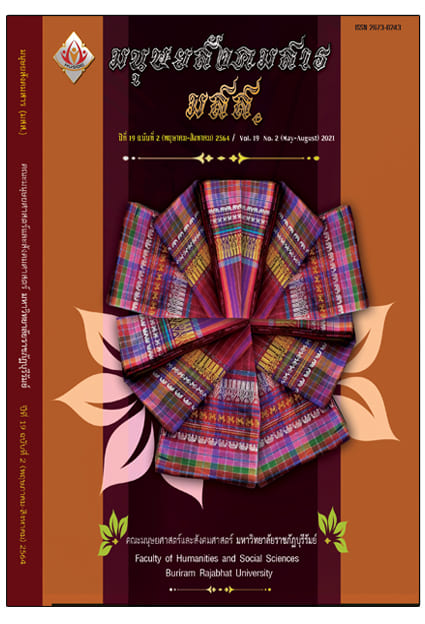ตัวบ่งชี้ความตระหนักทางวัฒนธรรมของผู้บริหารสถานศึกษา
Main Article Content
บทคัดย่อ
วัตถุประสงค์ของการวิจัยนี้เพื่อพัฒนาตัวบ่งชี้ความตระหนักทางวัฒนธรรมของผู้บริหารสถานศึกษา และทดสอบความสอดคล้องของตัวบ่งชี้ที่พัฒนาขึ้นกับข้อมูลเชิงประจักษ์ กลุ่มตัวอย่างคือ ผู้บริหารสถานศึกษาในจังหวัดสงขลา 250 คน ใช้วิธีสุ่มตัวอย่างแบบง่าย เครื่องมือวิจัยคือ แบบสอบถามวัดความตระหนักทางวัฒนธรรม 11 ข้อ วิเคราะห์สถิติทดสอบสมมติฐาน ด้วยการวิเคราะห์องค์ประกอบเชิงยืนยัน ผลวิจัยพบว่า ตัวบ่งชี้ความตระหนักทางวัฒนธรรมของผู้บริหารสถานศึกษา ที่พัฒนาขึ้น ประกอบด้วย ความตระหนักในวัฒนธรรมของตนเอง ความตระหนักในวัฒนธรรมของผู้อื่น และความตระหนักถึงความหลากหลายทางวัฒนธรรม มีความสอดคล้องกับข้อมูลเชิงประจักษ์ อย่างมีนัยสำคัญทางสถิติที่ระดับ .001 ค่าสถิติผ่านเกณฑ์การวิเคราะห์ค่าดัชนีความสอดคล้อง (χ²/df = 3.91, TLI = .89, CFI = .92, SRMR = .07, RMSEA = 10) จึงยอมรับสมมติฐานการวิจัย โดยค่าน้ำหนักองค์ประกอบของตัวบ่งชี้มีค่า .520 ถึง .771 ถือว่ามีนัยสำคัญทางการปฏิบัติ ค่าสัมประสิทธิ์สหสัมพันธ์ทุกตัวมีค่าเป็นบวก ค่าความเชื่อมั่นของแต่ละองค์ประกอบเท่ากับ .90 ถือเป็นค่าความเชื่อมั่นที่ดี และค่าความแปรปรวนที่สกัดได้เฉลี่ยเท่ากับ .46 ถือเป็นค่าที่มีความเที่ยงตรงเชิงเหมือนเพียงพอ ดังนั้น หน่วยงานที่เกี่ยวข้องสามารถนำผลวิจัยไปจัดทำคู่มือสมรรถนะทางวัฒนธรรมของผู้บริหารสถานศึกษาได้
Article Details

อนุญาตภายใต้เงื่อนไข Creative Commons Attribution-NonCommercial 4.0 International License.
เนื้อหาและข้อมูลในบทความที่ลงตีพิมพ์ในวารสารทดสอบระบบ ThaiJo2 ถือเป็นข้อคิดเห็นและความรับผิดชอบของผู้เขียนบทความโดยตรงซึ่งกองบรรณาธิการวารสาร ไม่จำเป็นต้องเห็นด้วย หรือร่วมรับผิดชอบใดๆ
บทความ ข้อมูล เนื้อหา รูปภาพ ฯลฯ ที่ได้รับการตีพิมพ์ในวารสารทดสอบระบบ ThaiJo2 ถือเป็นลิขสิทธิ์ของวารสารทดสอบระบบ ThaiJo2 หากบุคคลหรือหน่วยงานใดต้องการนำทั้งหมดหรือส่วนหนึ่งส่วนใดไปเผยแพร่ต่อหรือเพื่อกระทำการใดๆ จะต้องได้รับอนุญาตเป็นลายลักอักษรจากวารสารทดสอบระบบ ThaiJo2 ก่อนเท่านั้น
เอกสารอ้างอิง
Amaratunga, D., Malalgoda, C. I. & Keraminiyage, K. (2018). Contextualising mainstreaming of disaster resilience concepts in the construction process. International Journal of Disaster Resilience in the Built Environment, 9(4/5), 348–367. https://doi.org/10.1108/IJDRBE-10-2017-0057
Bakhov, I. S. & Motsar, M. N. (2015). The use of media educational technologies in formation of multicultural competence of future translators: Ukrainian experience. International Review of Management and Marketing, 5, 170–174.
Baltes, B., Hernandez, D. & Collins, C. (2015). Increasing cultural awareness through a cultural awareness program. Journal of Educational Research and Practice, 5(1), 1–20. https://doi.org/10.5590/JERAP.2015.05.1.01
Bennett, H. (2018). Review of the NZ college of public health medicine cultural competency and safety framework. Retrieved on 25 October 2020 from https://www.nzcphm.org.nz/media/131696/nzcphm_cultural_competency_proj_final.pdf
Brancu, L., Munteanua, V. & Golet, I. (2016). Understanding cultural intelligence factors among business students in Romania. Procedia–Social and Behavioral Sciences, 221(2016) 336–341. https://doi.org/10.1016/j.sbspro.2016.05.123
Centers for Disease Control and Prevention. (2014). Practical strategies for culturally competent evaluation. Atlanta, GA, USA: US Dept of Health and Human Services.
Clayton, J. K. & Goodwin, M. (2015). Culturally competent leadership through empowering relationships: a case study of two assistant principals. NCPEA Education Leadership Review, 16(2), 131–144.
Dangmei, J. (2016). Cultural intelligence: Bridging the cultural differences in the emerging markets. Paripex–Indian Journal of Research, 5(9), 284–287. https://doi.org/10.15373/22501991/September2016/72
El-Sheikh, A. A., Abonazel, M. R. & Gamil, N. (2017). A review of software packages for structural equation modeling: A comparative study. Applied Mathematics and Physics, 5(3), 85–94. https://doi.org/10.12691/amp-5-3-2
Fornell, C. & Larcker, D. F., 1981. Evaluating structural equation models with unobservable variables and measurement error. Journal of Marketing Research, 18(1), 39-50.
Galhanone, R. F., Rocha, T., Spers, E. E. & Rodrigues, F. (2019). The influence of corporate global mindset on international franchising, a study about Brazilian franchisors. RAUSP Management Journal, 1–16. https://doi.org/ 10.1108/RAUSP-08-2018-0069
Hair, J. F., Black, W. C., Babin, B. J. & Anderson, R.E. (2010). Multivariate data analysis: A global perspective. (7th ed.). New Jersey, USA: Pearson.
Hou, A. Y. C., Hill, C., Chen, K, H, J., Tsai, S. & Chen, V. (2017). A comparative study of student mobility programs in SEAMEORIHED, UMAP, and Campus Asia. Higher Education Evaluation and Development, 11(1), 12–24. https://doi.org/10.1108/HEED-08-2017-003
Houser, M. C. (2020). Looking through a culturally proficient lens: Georgia Elementary ESOL teachers' perceptions of school leaders. Doctoral dissertation, Georgic Southern University, USA. Retrieved on 20 October 2020 from https://digitalcommons.georgiasouthern.edu/cgi/viewcontent.cgi?article
=3313&context= etd
Jirwe, W., Gerrish, K. & Emami, A. (2006). The theoretical framework of cultural competence. The Journal of Multicultural Nursing & Health, 12(3), 6–16.
Jones, G., Chace, B. C., & Wright, J. (2020). Cultural diversity drives innovation: empowering teams for success. International Journal of Innovation Science, 12(3), 323–343. https://doi.org/10.1108/IJIS-04-2020-0042
Lam, L. W. (2012). Impact of competitiveness on salespeople's commitment and performance. Journal of Business Research, 65(9), 1328–1334.
Malazonia, D., Maglakelidze, S., Chiabrishvili, N. & Gakheladze, G. (2017). Factors of students’ intercultural competence development in the context of Georgia. Cogent Education, 4(1), 1–17. https://doi.org/10.1080/2331186X.2017 .1302867
Milner, H. R. (2018). The principal’s guide to building culturally responsive schools. Retrieved on 21 October 2020 from https://www.naesp.org/sites/default/fieles/ NAESP_Culturally_Responsive_Schools_Guide.pdf
Myers, N. D., Ahn, S. & Jin, Y. (2011). Sample size and power estimates for a confirmatory factor analytic model in exercise and sport: A Monte Carlo approach. Research Quarterly for Exercise and Sport, 82(3), 412423.
Polit, D. F. & Beck, C. T. (2006). The content validity index: Are you sure you know what's being reported? Critique and recommendations. Research in Nursing & Health, 29(5), 489–497.
Rahman, U. H. F. B. (2019). Diversity management and the role of leader. Open Economics, 2(1), 30–39. https://doi.org/10.1515/openec-2019-0003
Rew, L., Becker, H., Cookston, J., Khosropour, S. & Martinez, S. (2003). Measuring cultural awareness in nursing students. Journal of Nursing Education, 42(6), 249–257. https://doi.org/10.3928/0148-4834-20030601-07
Roysircar, G. (2004). Cultural self-awareness assessment: practice examples from psychology training. Professional Psychology: Research and Practice, 35(6), 658–666. https://doi.org/10.1037/0735-7028.35.6.658
Songkhla Provincial Education Office. (2019). Educational Information, Songkhla Provincial Academic Year 2019. Retrieved on 30 June 2020 from https://www.spe.go.th/news2/detail/11. [in Thai]
Soutphommasane, T., Whitwell, G., Jordan, K. & Ivanov, P. (2018). Leading for change: A blueprint for cultural diversity and inclusive leadership revisited. Australian Human Rights Commission. Retrieved on 17 October 2020 from https://humanrights.gov.au/sites/default/files/document/publication/Leading% 20for%20Change_Blueprint2018_FINAL_Web.pdf
Taber, K. S. (2018). The use of Cronbach’s Alpha when developing and reporting research instruments in science education. Research in Science Education, 48, 1273–1296. https://doi.org/10.1007/s11165-016-9602-2
Tavakol, M. & Dennick, R. (2011). Making sense of Cronbach’s alpha. International Journal of Medical Education, 2, 53–55. https://doi.org/10.5116/ijme.4dfb.
dfd
Vakili, M. M. & Jahangiri, N. (2018). Content validity and reliability of the measurement tools in educational, behavioral, and health sciences research. Journal of Medical Education Development, 10(28), 106–119. https://doi.org/10.29252/EDCJ.10.28.106
Vallejo-Garcia, J. L. (2012). Intercultural competence as a conductive factor of managers’ readiness for organizational change. (Doctoral dissertation, Université de Strasbourg, Strasbourg, French). Retrieved on 25 October 2020 from https://www.theses.fr/2012STRAB010.pdf
Wang, M., Shaowei, X. & Wang, Q. (2016). Discovery model of growing potential opportunity in e-commerce platform based on social network and entrepreneur trait. Proceedings of 2016 5th International Conference on Social Science, Education and Humanities Research (SSEHR 2016), 1079–1086.
https://doi.org/10.2991/ssehr-16.2016.231
Weiers, R. M. (2005). Introduction to business statistics: International Student Edition. (5th ed.). Pennsylvania, USA: Duxbury Press, Thomson– Brooks/cole.


